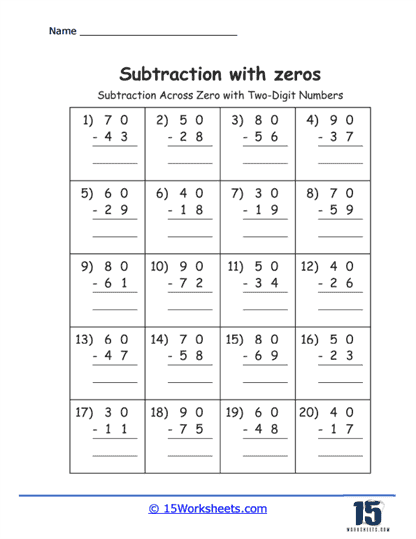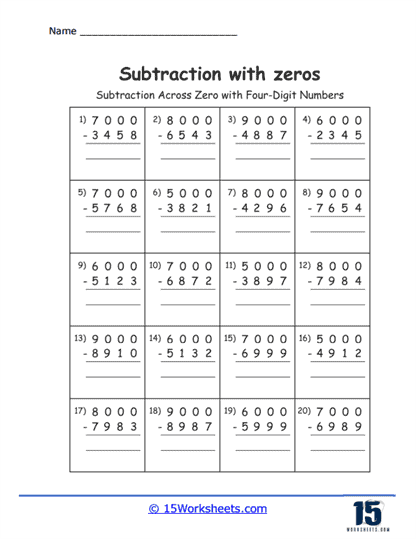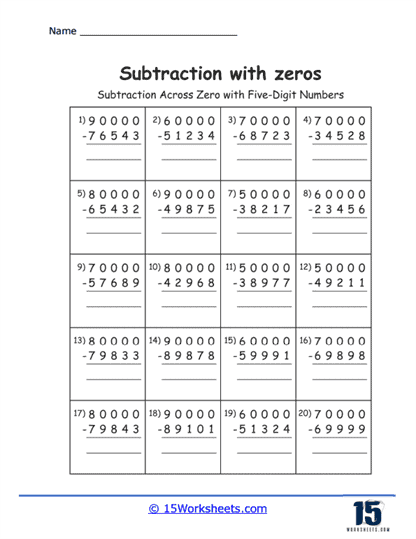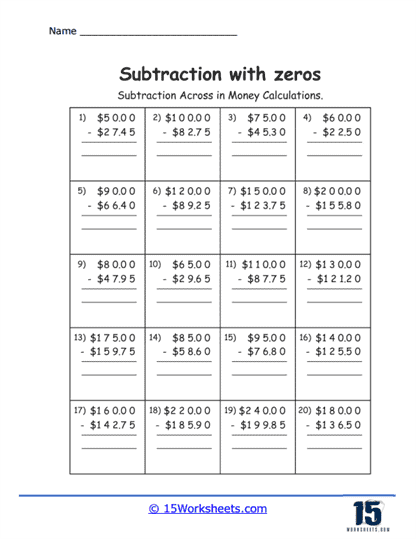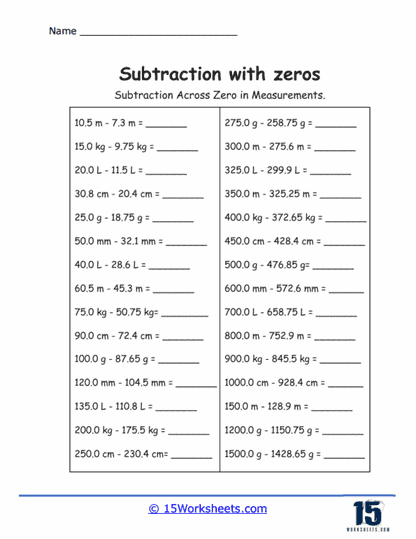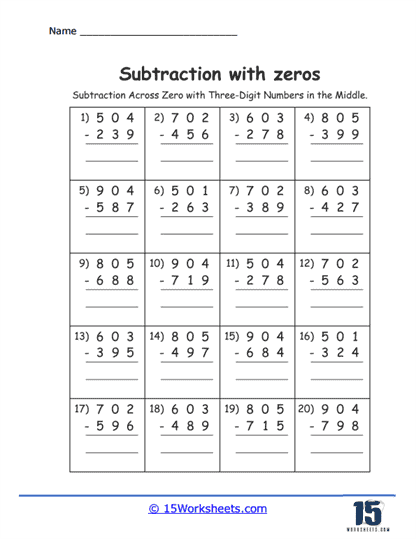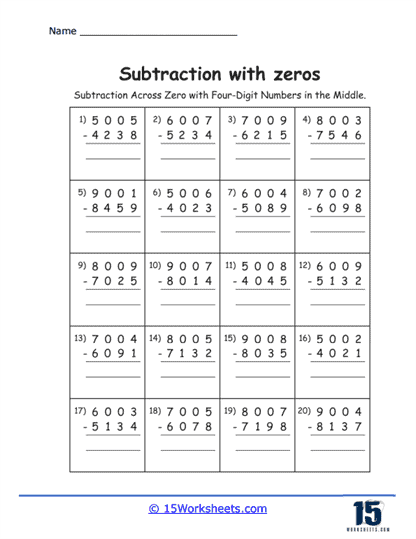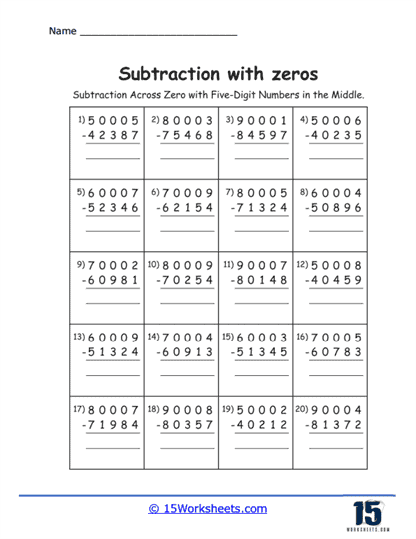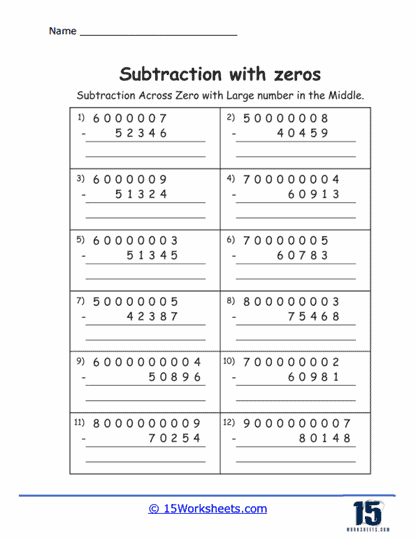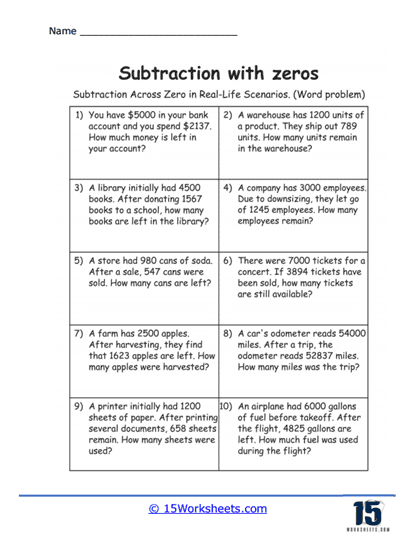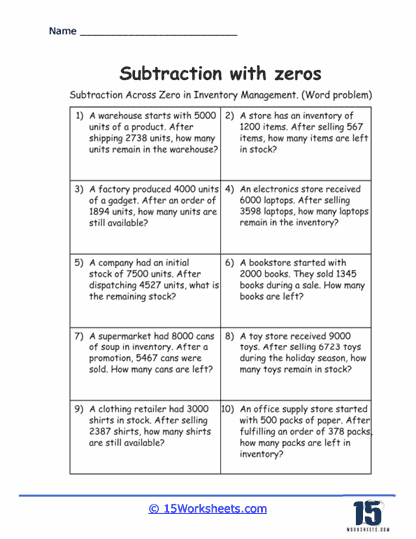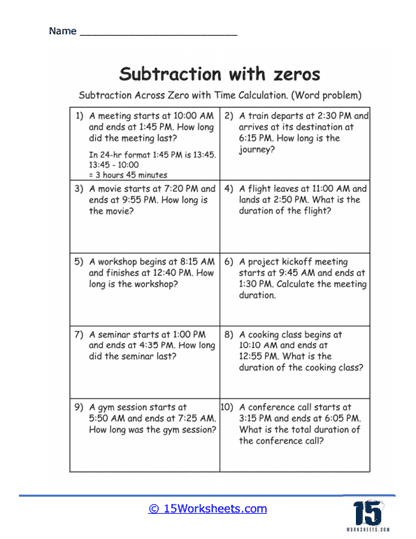Subtraction with Zeroes Worksheets
About These 15 Worksheets
These worksheets show students how to navigate the challenges associated with subtracting numbers that contain zeroes. These worksheets are especially beneficial for reinforcing concepts like borrowing, place value understanding, and working with large numbers, decimals, and measurements. Through a variety of problem types, students are exposed to different scenarios in which subtraction with zeroes plays a key role, helping them build a well-rounded understanding of subtraction across different contexts.
A common feature of these worksheets is the subtraction of large numbers that include zeroes in one or more place values. When students encounter problems with zeroes, they must apply the concept of borrowing or regrouping, which means “borrowing” from a higher place value to subtract from a lower one. For example, if subtracting 500 from 600, students need to understand that they must regroup the hundreds to borrow from the next higher place value to perform the subtraction. This can be tricky at first, but it is a vital skill for working with multi-digit numbers and ensures that students can handle real-world problems where large numbers often include zeroes.
One type of worksheet focuses on subtracting across zeros when dealing with very large numbers, such as millions or billions. These problems typically involve borrowing across multiple zeroes, which helps students build confidence in their ability to manage large numbers. In this type of subtraction, students are asked to subtract numbers such as 1,000,000 minus 987,654. Worksheets like these provide extensive practice with borrowing from multiple place values, which sharpens their understanding of place value while building computational accuracy.
Another type of worksheet emphasizes subtraction problems involving measurements. These problems might involve subtracting values such as meters, grams, or liters, and students are required to perform the subtraction across zeroes, similar to the way they would with whole numbers. The difference here is that the values are attached to real-world units, such as “10.5 meters minus 7.3 meters.” Worksheets focusing on measurements help students see how subtraction is applied in practical situations, particularly when measuring distances, weights, or volumes. This skill is especially useful in science, engineering, and everyday life scenarios.
In addition to large number subtraction, some worksheets emphasize the subtraction of decimals across zeroes. These worksheets ask students to subtract decimals that have zeroes in one or more decimal places, such as subtracting 12.75 from 15.00. The challenge here lies in maintaining proper place value alignment and applying the borrowing process when necessary. Decimals require careful attention to detail, and students must make sure the decimal points are properly aligned before attempting to solve the problem. By practicing with these decimal-based subtraction worksheets, students improve their ability to work with money, measurements, and other decimal-based numbers.
Time calculation is another interesting application of Subtraction with Zeroes worksheets. These problems are often word-based, asking students to subtract time intervals to determine the duration of events. For example, students might be asked to calculate the duration of a meeting that starts at 10:00 AM and ends at 1:45 PM. In this case, they must subtract hours and minutes, sometimes borrowing when the minutes in the first time are less than the minutes in the second time. This worksheet format helps students gain a deeper understanding of how subtraction applies to real-world problems like determining how long an event lasts or how much time remains until something happens.
Worksheets that focus on subtracting across zeroes using smaller, two-digit, or three-digit numbers are also common. These problems offer the perfect introduction to borrowing for students who are just beginning to learn subtraction with zeroes. For instance, a problem like “70 minus 43” requires students to borrow from the tens place to subtract correctly. These simpler subtraction problems help build a solid foundation in borrowing, giving students the confidence to eventually tackle more complex problems involving larger numbers and multiple place values.
Subtraction across zeroes with large numbers in the middle of the problem is another frequent challenge students will encounter. This type of problem typically presents a large number flanked by two smaller numbers on either side, requiring students to apply borrowing across several place values to solve the equation. For example, problems like “600,000 minus 523,000” require students to borrow multiple times across zeroes in the hundreds, tens, and ones places. These problems encourage students to master the skill of regrouping across place values while sharpening their focus on accuracy.
As students progress, they can practice subtraction with zeroes across varying difficulty levels, such as subtracting numbers with more digits or including more complex borrowing scenarios. More advanced worksheets may ask students to subtract multi-digit numbers with zeroes, such as subtracting 123,456,789 from 200,000,000. These types of problems challenge students to carefully apply the principles of borrowing and to keep track of each step in the subtraction process, which reinforces their overall mathematical understanding and accuracy in computations.
The goal of worksheets is to help students build confidence and fluency when subtracting numbers that contain zeroes. Whether they are subtracting large whole numbers, decimals, measurements, or time intervals, the concepts taught through these worksheets are essential for developing strong mathematical skills. Students must develop a deep understanding of place value, borrowing, and regrouping, which will serve them in solving more advanced math problems later on.
By working through a variety of problems involving subtraction across zeroes, students can sharpen their ability to handle complex subtraction equations, understand how to manage real-world numerical data, and become more comfortable with borrowing in different contexts. The ability to subtract numbers with zeroes accurately and efficiently is not only a critical math skill but also an important life skill that will help students in many practical areas, such as managing finances, working with measurements, and calculating time intervals.

